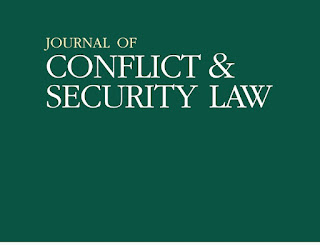Intensifying its engagement with UN peacekeeping in the past decade, Beijing has, in particular, supported and participated in peace operations that were not fully compatible with the consensual, impartial, and non-coercive models of peacekeeping traditionally employed by the United Nations.
China’s endorsement of offensive and intrusive missions is not inconsequential, given that it clashes with its professed adherence to rigid interpretations of the principles of sovereignty, non-intervention, and the non-use of force in international relations, MAURO BARELLI writes.
“[T]o make sense of China’s involvement in unconventional peacekeeping operations one must examine the broader process of foreign policy recalibration that is redefining the interests and priorities of the country as a new great power,” BARELLI writes in the
Asian Journal of International Law.
Furthermore, by examining China’s ambivalent approach to the principles that have traditionally defined the legal framework of UN peacekeeping, his article, titled ‘
China and Peacekeeping: Unfolding the Political and Legal Complexities of an Ambivalent Relationship’, highlights the opportunities and challenges that China will face as a provider of international security.
As a global economic power increasingly exposed to the risks and costs of conflicts around the world, the author states, China has naturally integrated into its foreign policy the question of instability in strategically important regions. In light of its non-confrontational nature, peacekeeping has been elected as an instrument capable of contributing to achieve the abovementioned objective without calling into question China’s continued adherence to a non-interventionist foreign policy.
Direct engagement in peacekeeping operations further allows China to project the image of a country committed to human protection, while offering its military an opportunity to improve its combat readiness. However, the author states, these benefits come with a number of challenges revolving around China's interpretation and application of the classic principles of peacekeeping.
The first set of challenges derives from the aggressive nature of the peace operations recently supported by China. Missions such as those in the Democratic Republic of Congo (MINUSCO), Mali (MINUSMA), and South Sudan (UNMISS) are authorized to use offensive, as opposed to defensive, force. In addition, MINUSCO and MINUSMA are instructed to target specific “enemies” rather than remaining impartial.
“Beijing can take comfort in the fact that peacekeepers are still deployed with the consent of the host state and are normally mandated to support the efforts of the latter in re-establishing peace and security,” BARELLI writes. Furthermore, the fact that offensive force has mainly been used to counter terrorist threats suits China’s ambition to become an important player in international efforts to combat terrorism, he adds.
At the same time, an escalation in the use of force by non-impartial peacekeeping units, both in itself and in combination with the consequences attached to it, raises a number of issues for Beijing given its traditional foreign policy posture and professed commitment to a strict interpretation of the principle of non-use of force in international law. This is even more so, considering that several states and influential UN reports have warned against the type of offensive operations conducted by MONUSCO and MINUSMA.
For these reasons, China has not formally endorsed the shift towards a more offensive form of peacekeeping, calling, instead, for the continued respect of the principles of impartiality and non-use of force except in self-defence. This has created a visible gap between its rhetoric and practice that will be difficult to bridge given the nature and dynamics of the competing forces at play, the author states.
A second challenge is represented by the practical difficulties that China is likely to encounter in defending a purely consensual model of peacekeeping. Peacekeeping forces can only be deployed with the consent of the host state, notably a requirement that, distinguishing peacekeeping from enforcement action, guarantees the alignment of the former with broader notions of sovereignty and non-intervention.
In practice, however, China has not always applied the parameters of consent in a very rigid manner, having endorsed and even participated in missions established against the will of the host state and later deployed in the absence of genuine consent.
“While engaging in not fully consensual operations may allow China to better defend its interests abroad in the face of host states’ reluctance to accept the offer of UN assistance, Beijing will have to constantly balance the benefits deriving from supporting intrusive operations with their potential effects on its commitment to rigid interpretations of the principles of sovereignty and non-intervention in international relations.”
Finally, the way in which China engages, as a permanent member of the Security Council, with modern peace operations will not only contribute to shape its identity as a great power increasingly engaged in conflict prevention and resolution, but can also have important implications for both the practice and doctrine of peacekeeping, BARELLI states.
In particular, China's continued support for offensive operations, especially when not qualified, could contribute to a process of legal validation of even more expansive interpretations of the principles of impartiality and non-use of force except in self-defence, while at a more practical level, and despite inevitable divergences of views and interests, its more active involvement in international peacekeeping efforts could provide the basis for a more fruitful collaboration with the other Permanent-Five in tackling contemporary global peace and security issues.
BARELLI, M. (2022). China and Peacekeeping: Unfolding the Political and Legal Complexities of an Ambivalent Relationship. Asian Journal of International Law, 1-20. doi:10.1017/S2044251321000606





















